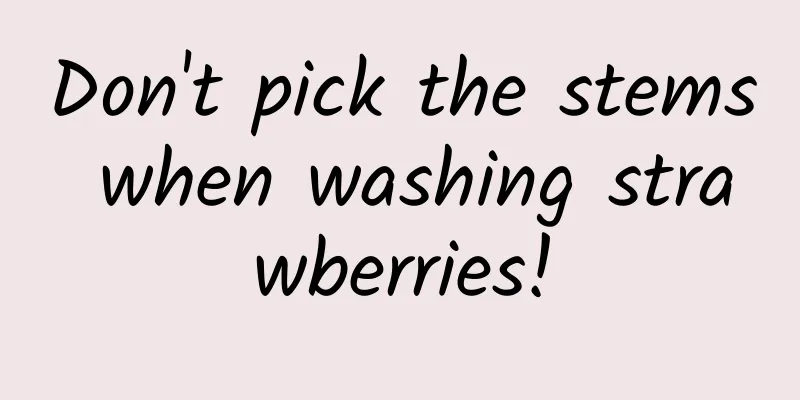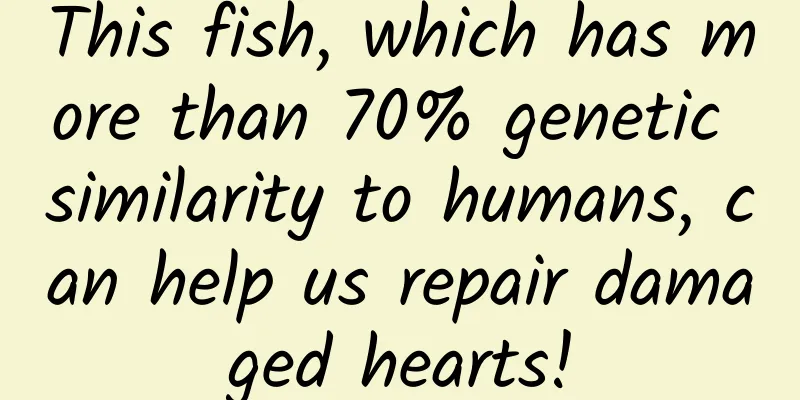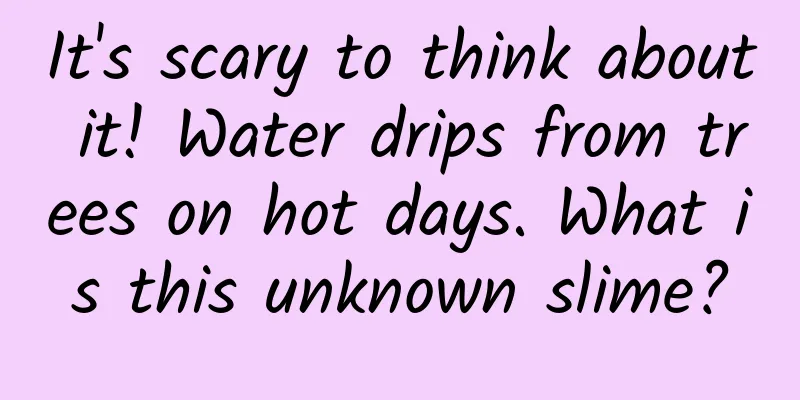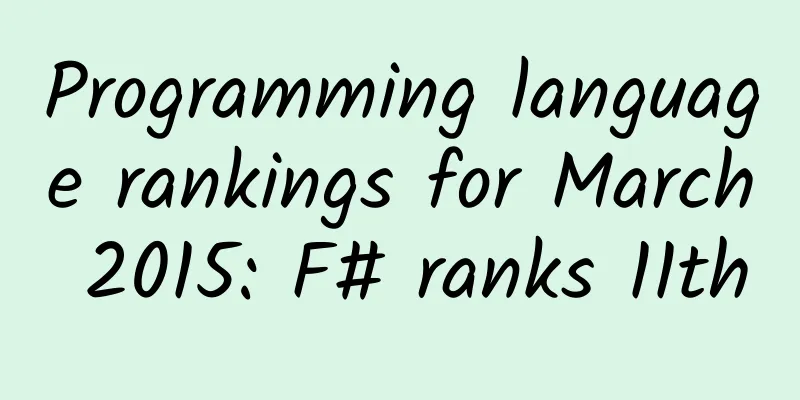Don't pick the stems when washing strawberries!

|
Too long to read When washing strawberries, do not remove the strawberry stems . Rinse them with clean water, then soak them in clean water, rice washing water, light salt water, or baking soda for 5 minutes and then rinse them clean. Strawberries are seasonal fruits in summer , and greenhouse technology allows us to eat strawberries in winter. Strawberries are sweeter in winter because the lower the fructose temperature, the sweeter it tastes. Strawberries are low in calories and high in nutritional value , so eat them with confidence! It’s the season for hot-selling strawberries again. When you take a bite of a bright red strawberry, the sweet and sour juice bursts between your lips and teeth, and the soft and tender flesh “melts” in your mouth. It’s so intoxicating! But have you really washed the strawberries you eat? Copyright images in the gallery. Reprinting and using them may lead to copyright disputes. When washing strawberries, be sure not to remove the stems! Someone has actually studied how to clean strawberries the cleanest. The most critical step: don't pick the strawberry stems! The researchers selected 3 kg of representative Shuofeng strawberries from supermarkets, fruit stores, and roadside fruit stalls, divided them into 8 portions on average, and performed the 8 washing methods shown in the figure below to compare the effects of different washing methods on pesticide residues in strawberry samples. Image source: Reference [18] Image source: Reference [18] The experimental results found that there is a clear difference in removing pesticide residues between removing the strawberry stems and not removing the strawberry stems. The pesticide residues in the strawberries that were soaked after the stems were removed were relatively higher . This is because if the stemmed strawberries are soaked in water, the residual pesticides will enter the fruit with the water, causing more serious pollution. In addition, the most recommended cleaning method is to rinse with clean water, then soak in clean water, rice water, light salt water, or baking soda for 5 minutes before rinsing. Image: Strawberry stem Image source: Photographed by the author Strawberries are actually summer fruits Strawberries are a type of berry, juicy, sweet and sour. When I was a kid, I could only eat strawberries in summer, and rarely in winter. But now, we can eat strawberries even in winter. Some people may wonder, "What season do strawberries come from?" In fact, strawberries are seasonal fruits in summer under natural conditions . The most suitable growth temperature is about 20℃. Generally speaking, when the soil temperature is between 15 and 23℃, it is suitable for the growth of strawberry roots; when the air temperature is between 20 and 25℃, the photosynthesis of strawberries is the best. Therefore, open-field cultivated strawberries are generally planted in August and September and harvested in May and June of the following year. The weather conditions at this time are most suitable for the growth of strawberries. The problem is: Strawberries are so delicious! They are in short supply. In order to let everyone enjoy strawberries in winter, greenhouse strawberry cultivation came into being. At present, my country ranks first in the world in terms of strawberry planting area and consumption, and almost 90% of strawberries are grown in greenhouses. Preparations for greenhouse strawberry cultivation usually begin in June to August, and the plants are planted around September. The harvest is ready for sale around New Year's Day, and the harvest period lasts up to 3 months. Copyright images in the gallery. Reprinting and using them may lead to copyright disputes. The low temperature outdoors in winter is not suitable for the growth of strawberries, and there is a risk of freezing to death. Greenhouse cultivation can artificially control temperature, humidity, pollination and soil conditions to ensure the healthy growth of strawberries. Therefore, strawberries have transformed from a "summer fruit" to a "winter fruit". Some people say: "Isn't this out-of-season fruit? It's not good for your health!" It’s true that strawberries are sweeter in winter! Many people have also found that strawberries in winter taste sweeter than those in summer. Is this an illusion? It’s not true! The sugars in strawberries include sucrose, glucose and fructose, with contents of 0.47g/100g, 1.99g/100g and 2.44g/100g respectively, among which fructose has the highest content. **Fructose has a characteristic that the lower the temperature, the sweeter it tastes,** so strawberries do taste sweeter in winter. Strawberries are not only delicious, but also nutritious. 1 Vitamin C When it comes to eating fruits, what people are most concerned about is whether they can supplement vitamin C. Strawberries make a great contribution to this. According to the data in the "Chinese Food Composition Table", every 100 grams of strawberries can provide us with 47 mg of vitamin C. However, the vitamin C content of different varieties varies. Figure: Vitamin C content of different strawberry varieties. Image source: References [8, 9] Eating 100~200g of strawberries every day can basically meet the general population's needs for vitamin C. Image: A strawberry half the size of a palm, about 25g Image source: Photographed by the author 2 Dietary fiber The insoluble dietary fiber content of strawberries is 1.1g/100g, and the total dietary fiber content is 2g/100g, with slight differences among different varieties. Figure: Dietary fiber content of different strawberry varieties Image source: Reference [10] 3 Mineral Potassium Although the potassium content of strawberries is not as high as that of bananas, it is 1.6 times that of apples, at 131 mg/100g, which is beneficial for maintaining healthy blood pressure. 4 Antioxidant ingredients The content of bioactive substances in strawberries is relatively high, about 2 to 11 times that of common fruits such as apples, citrus fruits, and kiwis. The bioactive ingredients they contain include total phenols, flavonoids, anthocyanins, etc., which have antioxidant and anti-inflammatory effects. Copyright images in the gallery. Reprinting and using them may lead to copyright disputes. 5 Low in calories The calories in strawberries are relatively low among fruits, only 32kcal/100g, which is lower than blueberries, mulberries, apples, pears, peaches, kiwis, etc. Even those who need to control their weight or are losing weight can enjoy strawberries without worry. In addition, a study recently published in "Nutrients" mentioned that long-term consumption of strawberries by middle-aged people can reduce the risk of dementia, but the study used 130g of strawberry powder supplemented daily. Don’t believe the rumors about strawberries! 1 Is the discoloration of strawberries caused by dyeing? No! The skin of strawberries is thin and delicate. If you wash them with a little force, you may break the strawberry tissue and cause anthocyanins to escape . This ingredient is easily soluble in water, so the water will change color. 2 Are white strawberries genetically modified? White strawberries are not genetically modified, but are artificially bred . There are many varieties of white strawberries, such as Peach Smoked, White Snow Angel, Little White, and Snow White Princess. 3 Are hollow and deformed strawberries injected with hormones? The hollowness of strawberries has nothing to do with hormones, but is related to the strawberry variety, growth environment, etc. For example, varieties such as Sweet Charlie have a low density of flesh and are relatively loose inside the fruit, which may lead to hollowness; excessive use of nitrogen fertilizer during the fruiting period can also lead to hollowness; sufficient boron is required for internal transportation of the fruit, and a lack of boron can also lead to hollowness of the fruit; insufficient nutrient supply or harvesting too late can also lead to hollowness. Copyright images in the gallery. Reprinting and using them may lead to copyright disputes. In addition, some people have studied the effect of chlorfenapyr on the hollowness and deformity of strawberries. The results show that variety is the main factor causing the hollowness of strawberries , and it is also a factor causing the deformity of strawberries . Regardless of whether chlorfenapyr is used during the strawberry planting process, the risk of hollow and deformed fruits will increase as the strawberries grow larger. Summarize: Strawberries are very nutritious and are normally seasonal fruits in summer. However, with the development of technology, greenhouse strawberry cultivation allows us to enjoy strawberries in winter! When washing strawberries, remember to "not remove the strawberry stems"! References [1] Wang Jian, Bai Jian. Analysis of strawberry growth environment and cultivation management technology[J]. Seed Science and Technology, 2021, 39(17): 83-84 [2] Wang Qianqian. Strawberry planting technology[J]. New Agriculture, 2022(5):16-17 [3] Cui Yan. Big data analysis of environmental impact on strawberry photosynthetic characteristics[J]. Hebei Agriculture, 2021(12):72-74 [4]https://fdc.nal.usda.gov/fdc-app.html#/food-details/167762/nutrients [5] Zhao Xiwu, He Yulian. Characteristics and application of fructose[J]. Beverage Industry, 2006(04):4-9. [6] Hao Zheng. Comparison of cold resistance of different strawberry varieties[J]. Agricultural Technology and Equipment, 2022(10):21-23 [7] Yang Yuexin. Chinese Food Composition Table 6th Edition Volume 1[M]. Peking University Medical Press, 2018 [8] Zou Yongzhou, Zhang Luyang, Niu Wenjing, Yang Lijuan, Zhu Xiaolei. Comparative study on fruit quality of different strawberry varieties[J]. Deciduous Fruit Trees, 2021, 53(5): 21-24 [9] Wang Gang, Yu Jinbu, Liang Fei, Jiang Jiyuan. Comparative study on fruit quality of different strawberry varieties[J]. Xinjiang Agricultural Reclamation Science and Technology, 2021, 44(5): 20-21 [10] Bai Sheng, Zhu Runhua, Yang Shengying, Qin Lin, Huang Shiqun. Comparison of nutritional components and variety screening of different strawberry varieties[J]. Shanxi Agricultural Science, 2020, 48(1): 64-67 [11] Wang Yuanxin, Song Jiaojiao, Ren Yinyin, Li Yinzhi, Zhang Bin. Comparison of bioactive substances and antioxidant capacity of different varieties of strawberry fruits [J]. Journal of Shanxi Agricultural University: Natural Science Edition, 2022, 42(1): 69-76 [12]Krikorian, Robert et al. “Early Intervention in Cognitive Aging with Strawberry Supplementation.” Nutrients vol. 15,20 4431. 19 Oct. 2023, doi:10.3390/nu15204431 [13] Wang Lihua. Management technology of key growth period of greenhouse strawberry in winter[J]. Modern Rural Science and Technology, 2022(2):40-40 [14] The national food safety supervision inspection pass rate in the first half of 2020 was 97.89% [J]. Food and Life, 2020, (9): 28-29. [15] Yan Ni, Wang Wensi, Shi Ce, et al. Risk assessment of pesticide residues in strawberry[J]. Anhui Agricultural Sciences, 2020, 48(15): 200-204. [16] Yu Xia, Cao Junjie, Wang Qianli, Hu Yongjiao, Ran Yan. Study on pesticide residues and heavy metal pollution in strawberries[J]. Guizhou Science, 2023, 41(4): 46-49 [17] Cao Qiumei. Risk assessment and regulatory recommendations for strawberry pesticide residues[J]. Food Safety Guide, 2021(3):80-80 [18] Shen Qinglong, Zhang Lengsi, Hou Lili, Qi Yu. Effects of different washing methods on the removal of pesticide residues from strawberries[J]. Agricultural Development and Equipment, 2018(12):120-120123 [19] Jin Shaoming, Ning Xiao, Gao Wenchao, He Huan, Cao Jin, Ding Hong. Study on the cleaning effect of different cleaning methods on pesticide residues in strawberries[J]. Journal of Food Safety and Quality, 2017, 8(7): 2549-2554 [20] Cang Tao, Song Wen, Zhao Xueping, Wu Changxing, Wu Shenggan, Chen Liping, Xu Mingfei, Zhao Huiyu, Wang Qiang. Effects of chlorfenapyr on hollowness and deformity of strawberry[J]. Journal of Zhejiang Agricultural Sciences, 2017, 29(9): 1537-1543. Planning and production This article is a work of Science Popularization China-Starry Sky Project Produced by: Science Popularization Department of China Association for Science and Technology Producer: China Science and Technology Press Co., Ltd., Beijing Zhongke Xinghe Culture Media Co., Ltd. Author: Xue Qingxin, registered nutritionist Review丨Ruan Guangfeng, Deputy Director of Kexin Food and Health Information Exchange Center Planning丨Fu Sijia Editor: Fu Sijia |
<<: How did Chinese scientists bring down the price of abalone? | BoLan Daily
Recommend
SpaceX Starship vs. Saturn V, the showdown of the century, Musk's dream of Mars is on the way (1)
(This article is a bit long and is planned to be ...
The SUV market has become hollowed out, and automobile research and development should not be rushed
It is hard to count how many SUVs have been launc...
To Xiaomi: Blessings and disasters lie somewhere in between
In the mobile phone industry, Xiaomi is a special...
The "overlord" soaring into the sky: How did dinosaurs "regain life" in the blue sky?
In the fourth-grade Chinese textbook published by...
How to add and modify creative materials, links, etc. in Baidu promotion assets in batches?
You can use Baidu Promotion Assistant to assist i...
How to operate single product on Douyin!
How can I find opportunities in Tik Tok’s niche c...
Is it useful to use dou+ if TikTok has no views? Is Douyin DOU+ useful?
When operating a Douyin account, there may actual...
Do you know how Thread works?
[[194846]] [Quoted from CoorChice's blog] Bac...
Juefei Technology strategically joins hands with Lanxin Technology to promote China's smart railway construction with artificial intelligence
Railways are an indispensable part of transportat...
In addition to selling traffic, there are many other ways to monetize new media.
Last Friday, the fashion giant "Rebecca'...
Example sharing: Innovative growth strategies of 12 top teams including Facebook, Airbnb, etc.
The original article lists 21 innovative growth e...
Are the “edited” vegetables delicious?
The cover image is a copyrighted image. Reprintin...
How to promote user growth by optimizing data!
With the development of the Internet, traffic has...
Google releases Fuchsia specification for its non-Linux operating system
Google has revealed details of its non-Linux oper...
What is the difference between cloud servers, virtual hosting and VPS?
For novice SEO website optimizers, the fastest wa...









